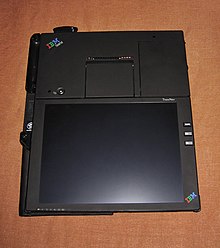A request that this article title be changed to ThinkPad TransNote is under discussion . Please do not move this article until the discussion is closed. |
 | |
 IBM ThinkPad TransNote | |
| Manufacturer | IBM |
|---|---|
| Product family | ThinkPad |
| Type | 2-in-1 PC, Graphics tablet |
| Release date | February 28, 2001 [1] |
| Discontinued | October 28, 2003 [2] |
| Operating system | |
| CPU | Mobile Intel Pentium III (Coppermine) @ 600 MHz |
| Memory | 64-320 MB PC100 SDRAM |
| Storage | 10 or 20 GB HDD |
| Removable storage | CompactFlash |
| Display | 10.4" SVGA TFT Touchscreen |
| Graphics | ATI Rage Mobility M |
The IBM ThinkPad TransNote is a notebook computer by IBM [3] that was launched in February 2001. [4]
